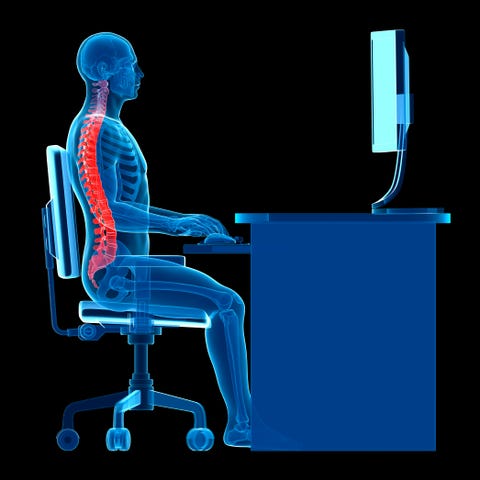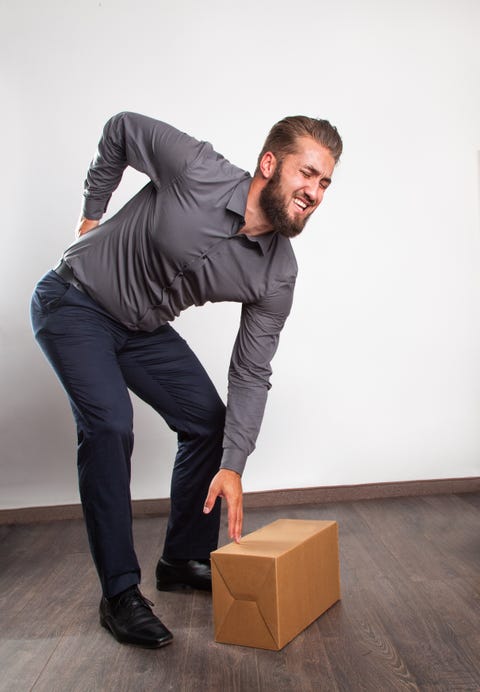Dan Giordano, P.T., D.P.T., C.S.C.S., is a member of the Men’s Health Advisory Board.
One of the most frustrating injuries out there: Back pain.
It’s debilitating, shooting pains that can wreck you for days. But there are ways to beat all this, and even get ahead of the game, and that’s what I’m hoping to show you right now. And yes, I know you may be thinking right now that you don’t have back pain, so this isn’t a concern.
But trust me: there’s a good chance you’ll experience back pain at some point in your life. And these drills can save you in those situations — even help you avoid the slightest pangs of travel back pain altogether.

Two Moves For Back Pain Prevention
Honing your back strength and mobility regularly will can help you avoid back pain. Do these stretches once or twice a week, when you’re not traveling, and they’ll prep your body to better handle the rigors of the road.
You won’t be able to do all these stretches in a plane or train, but you should master them.
Sitting Figure Four Stretch
While sitting, bend one knee and place your ankle on top of the other knee. While maintaining a neutral spine (do not round or hyperextend) lean forward to feel the stretch in your glutes. You may also lean towards the bent knee off the ground to feel a stretch in the lateral aspect of your glutes. Start with 10-seconds holds and progress to 30-second holds. Repeat 5 to 10 times on each side. (Pro-tip: Do this one while you’re traveling, if you can.)
Standing Hip Flexor Stretch
Stand with your feet shoulder-width apart, and take a step forward with right foot. Your knee will be bent. Just make sure you don’t lunge too far forward; think “knee behind toes”. Straighten out your left leg, tightening the glute, lean forward to feel stretch on front side of the left leg. If you don’t feel the stretch, raise your left arm above your head and slightly lean to the other side. Start with 10-seconds holds and progress to 30-second holds. Repeat 5 to 10 times on each side.
Five Moves for Back Pain Relief
If you’re already having low back pain, give these exercises a shot. It’s important to find out which movements (flexion, extension, rotation) cause pain or discomfort and to avoid those movements, while continuing to work into ranges that are not provoking. If you combine this stability program with mobility work (foam rolling and stretching) you should be able to build a solid foundation to help prevent and/ or relieve low back pain.
Transverse Abdominis Pushdown
Lie on your back with your knees bent, legs in the air. Your thighs should be perpendicular to the floor. Your calves should be perpendicular to the floor. Now place your right palm on your right thigh and your left palm on your left thigh. Lift your shoulder blades and tuck your chin. Press your hands into your thighs and press your knees toward your shoulders, creating an isometric contraction. Do not hold your breath as you do this. (If you feel pain in your lower back when doing this, either lower your head to the ground or try moving your knees closer to your shoulders.) Hold for 5 to 10 seconds, then relax. Do 10 reps.
Plank
The basic plank is one of the best moves to insulate your body against back pain.
Bird-Dog
Get on the ground on all fours, knees directly below your hips, hands directly below your shoulders. Keep your core tight and keep your gaze toward the ground. Reach your right arm out as far as possible and kick your left leg back simultaneously; squeeze your glutes as you do this. Keep your core tight; work to keep both shoulders and hips square to the ground. Return to the start. Repeat 10 times on each side.
Banded Bridges
Lie on your back with your knees bent and your feet flat. Place a resistance band above your knees, and press out on the band, opening your legs. Continue pressing out throughout this movement. Brace your core and squeeze your glutes, then raise your hips. Your goal is to create a straight line from torso through thighs. Keep your heels on the ground as you do this. Return to the start. That’s 1 rep; do 10 per side.
Your Back Pain Travel Rules
Even if you’ve never had general back pain, there’s a good chance you’ve experienced slight pangs of it when you travel. Why? Because everything about long-distance travel in planes, trains, and even cars seems designed to aggravate our lumbar area.
The seats in airplanes, cars, and trains simply aren’t designed to be comfortable, period, so they’re even worse for you when you’re struggling with back pain. Hamstrings and hip flexors stiffen, making for hours of pain, and you feel it when you try to get out of that seat after the trip.
To avoid all that, keep these tips in mind when you hit the road.
Move
One key to both avoiding and alleviating back pain: Move. The more you move around, the better. Dr. John J. Michalisin Jr., M.D., a clinical assistant professor of physical medicine and rehabilitation at the NYU School of Medicine recommends that you “try to move around and change positions frequently.”
So every 30 minutes, get up. Set an alarm to make sure you do it when you fly or take the train. You only need to do it for 60 seconds, but stand up, stretch your arms overhead, and “dethaw” your body so it doesn’t grow frozen and tight in bad positions. You’ll commonly get up from your seat with tight pecs from hunching slightly, and tight hip flexors from having your legs bent for so long.
Ponder Your Sitting Posture

Getty ImagesSEBASTIAN KAULITZKI
Make sure your butt is all the way back in the chair and shoulder blades against the chair. “Do not sit forward. Sitting while leaning forward, causes an increase in intradiscal pressure”, says Michalsin.
If you can adjust the sit, make sure your knees are in line with your hips or slightly lower. If you are still uncomfortable try rolling up a towel (or your sweatshirt) and position it between your lower back and the seat, helping to maintain the natural curvature of your spine.
Lift Smartly

Getty ImagesCarsten Schanter / EyeEm
The more you pack, the more you have to carry. When putting luggage above your seat, perform this in steps. Squat down, pick up the luggage keeping the luggage close to your body (the further away from the body it moves, the further your center of gravity moves away from your base of support).
Never twist when you are holding your luggage, instead pivot your feet to get where you need to be. As you lift the luggage overhead, use your legs and stabilize your core.
Source: Read Full Article
